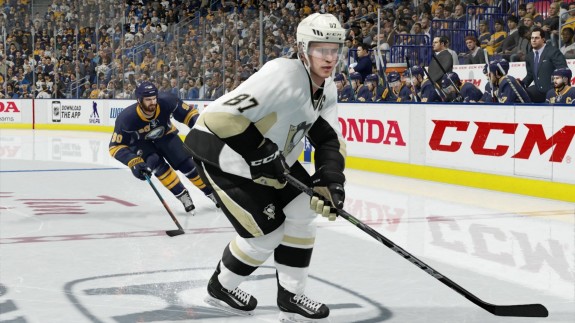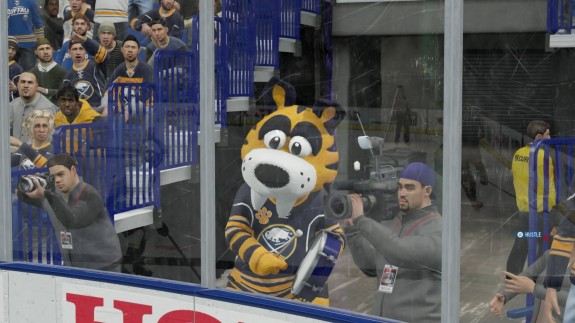It’s been a rough 12 months for the folks up at EA Sports Vancouver. After taking an extra year before bring the NHL franchise to the next-gen consoles, EA Sports released NHL 15 to much criticism for lack of modes and gameplay features.
The release of NHL 16 on the Xbox One and PlayStation 4 aims to rebuild the trust between publisher and fan base, and bring the hockey experience, officially, to the next generation of gaming.
One of the biggest problems with NHL 15 was that, even though the game looked more realistic, the gameplay felt more arcade-like than in the prior years. It was clunky, buggy and all-around stiff one next-gen consoles a year ago.
This year, the developers reached out to a group of fans to help improve the game both on and off the ice. From control schemes to default sliders, the “playmakers” group was given full access to the game throughout development to help guide in the production.
New controls for goaltending were developed thanks to the help of Carolina Hurricanes netminder Eddie Lack, making the position more fun to play.
NHL 16 sees the skating flow as smooth as ever, puck physics that are better than ever and player interactions that look more authentic. Players crash the net without ramming aimlessly into the goaltender, penalties are more logical and strategy actually plays a role in winning a game. The one major gripe with penalties is the fact that clear interference isn’t called yet getting hit while getting up from blocking a shot draws a tripping penalty on the person getting hit.
No more should players expect to skate into the zone, fire a slap shot and expect to score. Sometimes a dump and chase is necessary to have a successful possession, and working the puck around is more encouraged than ever before. The A.I. sees improvement with fewer out of position and head scratching moments.
Off the ice, the game is more detailed than the bare bones version that fans received last year. Modes are fully featured, and actually have the base for something really promising in the coming years.

Be A GM and Be A Pro see improvements, albeit slight. Player morale is the biggest addition to Be A GM as it adds a new wrinkle to roster management and the ability to lure and keep free agents. If you aren’t keeping your star players happy, the chances of them sticking with you when their contracts come up are slim to none. The ability to manage and play as your AHL club also makes a return to the mode.
With Be A Pro, the improvements don’t make too much of a difference compared to past versions of the mode. The coach feedback is a lot more accurate than in the past, and the way you play on the ice alters the type of player you become. That means that even if you choose to be a sniper when you start, if you play more like a power forward, that’s what you will become. Aside from that, however, nothing feels special about this mode.
Hockey Ultimate Team is still the bread and butter mode of the game, and it adds a much-requested feature to the mode. The addition of single player seasons allows players to fine tune their roster and hone their skills before taking their talents online against other players across the globe. There are four different ranks of single player seasons to choose from that all vary based on the makeup of your roster.
Couch co-op and six-on-six online play also return to the game for players to enjoy.
Of course, the big returning mode that was left out of last year’s effort is EA Sports Hockey League (EASHL). EASHL allows players to take their created players, and form a team with friends to compete in online seasons for league titles.
The big change in the mode this year is the removal of upgrading attributes. Instead, each player type has a set attribute allotment, making for more fair play across the board that relies on skill much more than ever before. Almost everything returns from the old EASHL aside from the aforementioned attributes as well as the ability to design your own jerseys. Instead, players just have to select a jersey combination that’s also in the game.
One major improvement in the mode comes in the form of input lag and response time. During the mode’s beta in August, the response time made it nearly impossible to play goaltender with any sort of success. That issue has been resolved with the full release, and the overall response is the best it’s been in a long time.
Visually, the game is a slight upgrade from NHL 15. Some players have had their faces scanned and updated in the game, but far too many big-name players are without accurate head scans. Those players include Milan Lucic and Phil Kessel, among others. With a sport where players’ faces are often seen by the fans, the more accurate scans the better for the game. Also, adding more designs for goalie helmets — the Buffaslug should not be on the helmet templates — and jersey options should be something the developers do now that the new generation is established.
But hey, and this isn’t sarcastic in the least, users are finally able to fully edit current players’ equipment and numbers any way they see fit.
The overall presentation is where the game seemingly improved the most away from the returning modes and gameplay. Each arena touts authentic goal songs, though it appears that most have had their pitch and tones lowered for reasons unknown. Also added, for the artists that agreed to lend the rights to their songs, are authentic goal songs for a number of teams. Before you even ask, the answer is yes, Chelsea Dagger is in the game in the debuting United Center.

Team’s have their mascots. Little arena nuances like the cannon in Columbus and the “Yes” chant in New York make their debuts in the game as well. The NBC graphics have been updated, and the commentary from Mike Emric, Eddie Olczyk and Ray Ferarro sounds less robotic and more live than last year. It doesn’t do anything to the gameplay, but it adds a special feeling of realism to a franchise that needed it.
Overall, NHL 16 takes a nice base model that was established with 15, and improves on it in ways that make the game better in almost every aspect. Even if modes like Be A Pro and Be A GM could use some more fresh features, there is still enough to offer to keep players coming back months later to enjoy the game.
The NHL franchise may not be 100% back, but the strides made with this year’s version of the game should only leave fans even more hopeful that the series is set to return to glory.